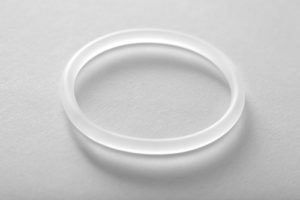Back to Contraception List
The vaginal ring is a small, soft plastic ring that you place inside the vagina. It’s about 4mm thick and 5.5cm in diameter. IT is left in the vagina for 21 days, then removed and thrown into the bin . Seven days after removing the ring, you insert a new one for the next 21 days (HSE, 2017). It is vitally important that it is at the same time as the you removed it i.e. if it was removed at 1pm on a Saturday, it must be inserted back in at 1pm on the following Saturday. 
The ring releases oestrogen and progestogen. This prevents ovulation (release of an egg), makes it difficult for sperm to get to an egg and thins the womb lining, so it’s less likely that an egg will implant there. The ring serves as a low dose hormonal contraceptive. Over the three weeks the Ring is in place the hormones are absorbed directly into the bloodstream through the vaginal wall (IFPA, 2017). When used properly, the ring is 99% effective. There is only one ring available at this time it is called NuvaRing.
Benefits of choosing the Vaginal Ring
- Convenient once a month replacement
- Easy to remember compared to taking daily pills
- The process is done by the woman herself
- Is a low level of hormones in your body
- Natural cycles return quickly when you stop using the vaginal ring
- Does not interrupt sex
- Neutral effect on weight
- Not affected by vomiting or diarrhoea
Disadvantages of choosing the Vaginal Ring
- Some medication can reduce how effective the vaginal ring is therefore its recommended that another contraceptive method should be used if taking medication
- Does not protect against STIs
- Only available by prescription
- Unsuitable for woman who smoke, those who are 35+ and those who have high blood pressure
- Unsuitable for women who are currently breastfeeding
- Costs more than the pill (HSE, 2016)
- Women using it must be comfortable about inserting a ring into her vagina
- May sometimes be felt by her partner during sex
- May cause increased vaginal discharge or irritation
- May fall out -usually with bowel movement (Rare) (IFPA, 2017)
For more information on the vaginal ring, click on any of the following links;